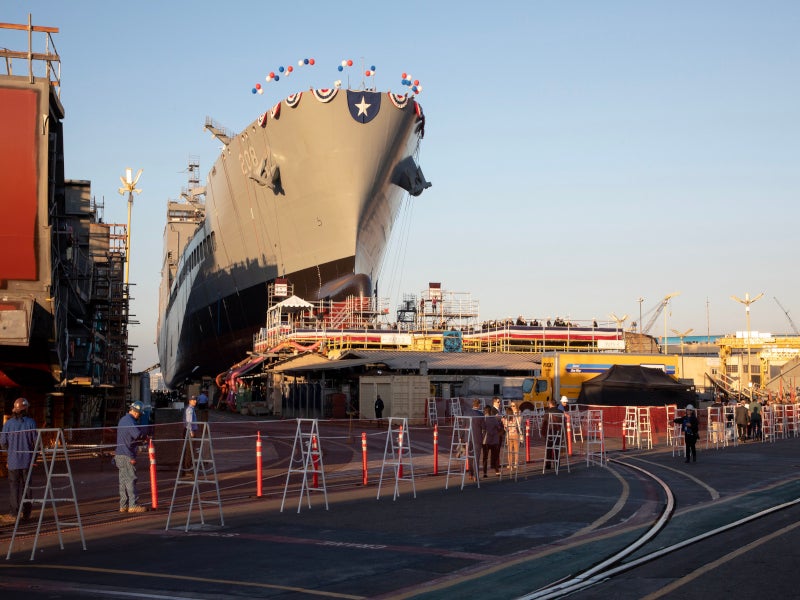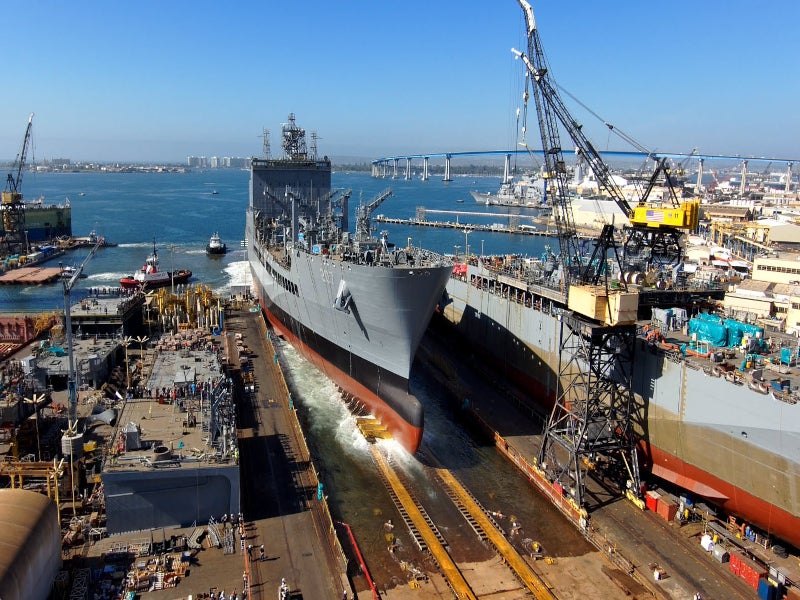John Lewis-class, previously known as TAO(X), is a fleet of replenishment oiler ships being developed by General Dynamics National Steel and Shipbuilding (NASSCO), a US-based shipbuilding company, to replace the US Navy’s existing fleet of Henry J Kaiser-class tankers.
The ships are being developed within the framework of the US Navy’s John Lewis-class fleet oiler programme.
The next-generation oilers will be operated by the US Navy’s Combat Logistics Force of the Military Sealift Command.
The ships are used to transfer fuel to combat support ships during an underway replenishment at sea to extend the endurance of the ships and aircraft. The tankers can also supply ammunition, fresh water, lubricants and dry cargo.
Construction
Construction began with the first steel cut for the lead ship in the class, USNS John Lewis (T-AO 205), in September 2018. The ship was launched in January 2021, following the completion of construction and christened in July 2021.
Construction of the second vessel, USNS Harvey Milk (T-AO 206), started in September 2020, while construction of the fourth in the class, USNS Robert F Kennedy (T-AO 208), began in May 2021.
USNS Harvey Milk (T-AO 206) was christened and launched in November 2021. The company began the construction of the fifth vessel, USNS Lucy Stone (T-AO 209), in October 2022.
The keel-laying ceremony for USNS Robert F. Kennedy (T-AO 208) was held in December 2022. The third ship, USNS Earl Warren (T-AO 207), was christened in January 2023. The construction of the USNS Sojourner Truth (T-AO 210), the sixth ship for the programme, began in March 2023.
The USNS Harvey Milk (T-AO 206) was delivered to the US Navy in July 2023. The USNS Robert F Kennedy (T-AO 208) was christened and launched in October 2023.
John Lewis-class fleet oiler programme details
The US Navy plans to procure a total of 20 John Lewis-class oilers under the John Lewis programme, which is named after American civil rights leader John Robert Lewis.
The ships are expected to cost approximately $650m each when the procurement rate is two ships a year and slightly more when it is one ship a year.
A request for proposal (RFP) for the design and construction of the first six ships was issued in June 2015. Funding for the first and second ships, which are estimated to cost $1.05bn, was approved in 2016 and 2018, respectively.
The US Navy awarded a block-buy contract to General Dynamics NASSCO to perform detailed design and construction of the first six John Lewis-class ships in June 2016.
General Dynamics received $500m to support the construction of the seventh and eighth ships (T-AO 211 and T-AO 212) of the T-AO programme in June 2022. Additionally, the company received $1.4bn for the construction of T-AO 211 and 212 and a sixth Expeditionary Sea Base ship (ESB 8) ship, with an option for the Navy to receive the ninth John Lewis-class ship T-AO 213 in August 2022.
General Dynamics received $736m for the construction of T-AO 213 for the programme in May 2023. The vessel’s construction is scheduled to begin in the third quarter of 2025.
John Lewis-class design and capacities
The John Lewis-class design is based on the Henry J Kaiser-class replenishment oiler ships. The double-hull design concept of the ship provides a high level of protection against damage to the inner hull. The 745ft-long vessel has a full load displacement of 49,850t.
The new replenishment tankers have the capacity to carry 156,000 barrels of oil, including biofuels and are fitted with a helideck with the capacity to conduct refuelling for helicopters. The new ships can also hold more dry cargo than their predecessors.
The John Lewis-class meets the Oil Pollution Act 1990 and international marine pollution regulations.
Armament and self-protection
The ship can be armed with a close-in weapon system or a SeaRAM (Rolling Airframe Missile) anti-ship missile defence system for detecting and destroying anti-ship cruise missiles. An anti-torpedo torpedo defence system is also fitted to provide protection against torpedoes.
The John Lewis-class can also carry crew-served weaponry to offer protection against fast-attack craft.
The oilers are armed with a Nixie torpedo countermeasure system to counter torpedo attacks. An advanced degaussing system is installed to protect the ship from modern magnetically fused sea mines.
Propulsion and performance of John Lewis-class ships
Fairbanks Morse was awarded a contract by the US Navy to supply engines, propulsion control systems, auxiliary equipment and commissioning services for the lead ship in August 2016. An order for an additional 34 engines was placed in March 2017.
Each replenishment oiler is powered by a pair of 19,000bhp Fairbanks Morse MAN 12V 48/60 CR four-stroke diesel engines.
The engines are outfitted with an exhaust after-treatment system, common rail fuel injection and engine control systems to provide improved fuel efficiency.
The propulsion system provides a speed of 20kt.






